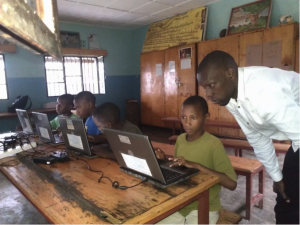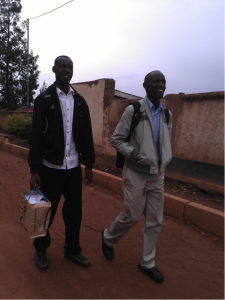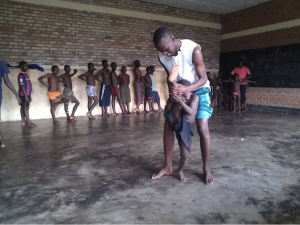“To dance is good, to teach kids how to dance is great.” – Bashir Karenzi
If asked to describe how dance is used to help vulnerable children, I should invite one to come and work beside the RDDC team for about three months. This is how one can really understand how dance can be used as a tool for social change. Dance can go beyond the stage and realize miracles. Through the art of dance, kids change. They gain confidence and hope in a better future. Those are the words I used to explain our mission to Bashir Karenzi, my new co-team member who joined the RDDC Rwandan team last month (August).
Bashir visited the RDDC dance program for the first time in November 2012. He was actually looking for dance space for him and his dance team from Inshoza Dance Company, which is based at the National University of Rwanda. Bashir seemed to be excited and interested in how some new kids were deeply motivated to learn basic dance steps while other kids – those not dancing – had been fighting outside. After six months, Bashir Karenzi and his friends from Inshoza were invited to attend a special dance training: “Train the Trainers” organized by RDDC to promote dance in Rwandan youth and increase the capacity of dance teachers.
When Bashir came for this training, he observed the children’s practice again and was surprised to realize that there were no kids outside anymore; everyone was inside dancing. “How come all kids are dancing now?” Bashir asked. I told him that, if he really wants to understand the process, he should come and volunteer for a few weeks and try finding the answer to his question. Bashir accepted to volunteer for the whole month of July 2013. Since then, my team and I have been watching Bashir become more and more interested in street kids. He is motivated in teaching them some steps before dance class as well as responding to their various questions about life, school, science and so many other issues. October is going to be the third month of Bashir’s time with RDDC – and now it has turned into full time employment. He helps Innocent and Ssali in teaching dance and IT, and then assists me with logistics.
It is now my time to ask Bashir a question:
 Q: “Why did you want to work for RDDC?”
Q: “Why did you want to work for RDDC?”
Bashir: “I really like dance. I would pay any price to keep learning this great art and perform it on stage as well. After the positive change I saw with my own eyes during this month of volunteering, I changed the way I perceive dance: I didn’t realize that Dance plays a role in helping people to change the way they behave; now I am happy to give my little contribution to helping these vulnerable children. Most of these street children are so talented; some of them can become professional dancers in the future. I wish I could turn back the end of time and get the same chance as those kids – to learn dance regularly. I feel so energized when I watch kids moving during dance class. There are super talented kids, like Jean Paul Mugisha, Fulgence Niyongana, Alphonse Nzayisenga and Manishimwe. When I am teaching those kids, it gives me the courage to keep teaching.
Everything Bashir says is true when I watch him. If I don’t remind him to stop teaching, Bashir can teach until 7:00pm at night – two hours overtime!
“I believe that Dance can go beyond the stage and be used as a tool, a stimulus for social change,” Bashir concluded.
Eugene Dushime is the Country Director for RDDC Rwanda. He is a former contemporary dancer and assists with the RDDC program in Guinea as well.

